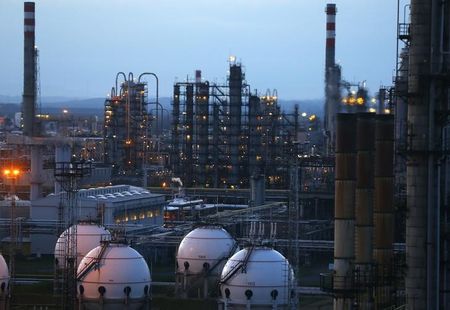Commodities
Oil prices edge higher after initial claims boost rate cut optimism

Investing.com — Oil prices edged higher Thursday, extending a rebound from four-month lows as optimism over lower interest rates in the coming months offset an unexpected build in U.S. inventories.
At 08:55 ET (12:55 GMT), rose 0.1% to $78.44 a barrel, while rose 0.1% to $74.14 a barrel.
Both contracts surged nearly 2% on Wednesday after sinking to four-month lows.
Rate cut hopes support crude
Oil prices rose tracking a broader increase in risk-driven markets, as weak U.S. labor data fueled bets that the Federal Reserve will begin .
Data released on Thursday added to this sentiment, as the number of Americans filing for rose by 229,000 last week, more than the expected 220,000.
The U.S. labor market has shown signs of cooling of late, with data released on Wednesday indicating that increased at a slower-than-anticipated rate in May, following on from a soft print the day before.
Friday sees the release of the widely-watched monthly report.
Adding to the hopes of looser monetary policy globally was a rate cut by the earlier Thursday, following on a similar move by the on Wednesday.
Hefty weekly losses on OPEC+, US inventories
That said, the crude benchmarks are still on course to post weekly losses of around 4% after the Organization of Petroleum Exporting Countries and allies (OPEC+) signaled it could begin scaling back production cuts this year.
Additionally, government inventory data showed on Wednesday that U.S. grew by 1.2 million barrels in the week to May 31, compared to expectations for a draw of 2.1 mb.
grew by a bigger-than-expected 3.2 mb, while grew slightly less than expected at 2.1 mb.
The overall builds in stockpiles raised some concerns over cooling demand in the world’s biggest fuel consumer, even as the travel-heavy summer season began.
OPEC+ could walk back phasing out supply cuts – Roth
Sustained weakness in oil prices could see the OPEC+ walk back on its plans to begin phasing out production cuts this year, Roth MKM analysts said in a note.
The cartel said at its latest meeting that it intends to begin scaling back 2.2 million barrels per day of production cuts from October 2024 to September 2025. This triggered a sharp decline in oil prices.
But weakness in the oil prices may see the OPEC+ postpone, or even put off any plans to increase production.
(Ambar Warrick contributed to this article.)
Commodities
Oil prices rise; U.S. crude inventories plunge, Russia-Ukraine truce eyed
Commodities
India’s Reliance to stop buying Venezuelan oil over US tariffs, sources say
Commodities
Oil prices climb on Venezuela supply worries

 Forex3 years ago
Forex3 years agoForex Today: the dollar is gaining strength amid gloomy sentiment at the start of the Fed’s week

 Forex3 years ago
Forex3 years agoUnbiased review of Pocket Option broker

 Forex3 years ago
Forex3 years agoDollar to pound sterling exchange rate today: Pound plummeted to its lowest since 1985

 Forex3 years ago
Forex3 years agoHow is the Australian dollar doing today?

 Cryptocurrency3 years ago
Cryptocurrency3 years agoWhat happened in the crypto market – current events today

 World3 years ago
World3 years agoWhy are modern video games an art form?

 Commodities3 years ago
Commodities3 years agoCopper continues to fall in price on expectations of lower demand in China

 Economy3 years ago
Economy3 years agoCrude oil tankers double in price due to EU anti-Russian sanctions























